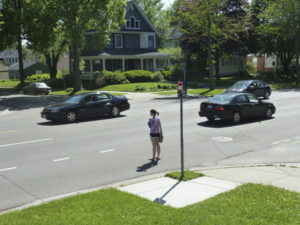Ethics
Bill Schultheiss, PE, Vice President and Director of Design, on the importance of ethics in transportation design
September 6, 2019
Dive Deep into Why Ethics Matter

I’ve completed a lot of ethics training over the years in order to maintain my Professional Engineer licensure in 25 states around the country. I know pretty much everything there is to know about preventing and avoiding graft and the perils of practicing without a license. It saddens me to say that I have never been asked in one these courses about the ethics of designing or approving an intersection design that is highly likely to result in people on foot getting killed or seriously injured. I’ve never had to discuss the morality of choosing to design and build urban streets with no sidewalks or bike infrastructure. I’ve never been asked to weigh the risk of death or injury in allowing motorists to turn left across 50 mph traffic.
Many engineers like to believe science and math can be used to make objective decisions. Unfortunately, too many of the resulting formulae, warrants, checklists, models, and standards can then make it seem as if we have no choice but to design streets and highways that favor automobiles to the exclusion of everyone and everything else. But the truth is we have a lot of flexibility and engineering judgment to exercise, and the answers are not always going to come from a math equation. We are making values-based choices all the time.
One of my first assignments at Toole Design 15 years ago was to deliver Complete Streets training to groups of DOT engineers. Then, as now, (e.g. when we deliver courses on FHWA’s Bikeway Selection Guide) we explain that planners and designers are constantly making trade-offs based on space, funding, politics, data, existing conditions… and values. In almost every one of those decisions, there is an ethical issue that is just as important as a technical one — and yet we rarely ask ourselves about the former.
Vision Zero policies and programs are really bringing this home to more and more practitioners — because, with a policy goal of zero deaths and serious injuries, each decision is literally a matter of life and death. I recently wrote an article for the National Society of Professional Engineers magazine and was honored to present at the 2019 ITE International Conference in Austin on just this topic, and I can tell you that it’s a challenging issue to confront.

For years we’ve been able to say that 94% of crashes are the result of human error — because that’s the official number that NHTSA puts out there – and that’s effectively a dodge that has allowed ourselves to put the burden for safety on the 30-40,000 people who die and the hundreds of thousands who are injured every year on American roadways. But, thanks to the growing presence of Vision Zero programs, that is no longer the case. We are finally confronting our responsibility for a transportation system that has produced this level of death and injury for almost 100 years.
You’ll know if you follow me on Twitter that our profession is also finally starting to talk about our role in supporting historic inequities and institutional racism in every community in the country through highway building, suburban development, redlining, urban renewal, and so on.
As my Toole Design colleagues and I discuss these emotional and challenging topics, we have come to the realization that unless we start making values-based decisions centered on ethics, equity, and empathy, we will be complicit in the preservation of a status quo that is manifestly unfair, unsustainable, and unsafe.
We are not prepared to do that, and we don’t want to be among the few people and firms out there talking about these issues. We want the planning, design, and engineering professions to travel this road with us. And I want to see some new material in those ethics courses I have to take.
Vice President | Director of Design
The New E’s Podcast
Why has the conversation on ethics in transportation centered around business practices, rather than design outcomes? How do we assign responsibility for crashes in the roadway system when our streets do not provide accommodations for all users? How can our professional understanding of ethics evolve to better uphold the safety, health, and well-being of the people who use our roads?
On episode 2 of the New E’s of Transportation podcast, Jennifer Toole, AICP, ASLA sat down with Bill Schultheiss, PE, and Jeff Paniati, PE, President of the Institute of Transportation Engineers, for a conversation about the ethical responsibilities of transportation professionals. The discussion covers how the profession talks about ethics, how the understanding of ethics has affected our responsibilities for safety, and how design guidance and clear definitions of responsibility can deliver better safety outcomes for people who walk, bike, and drive in our communities.
The fact that we suggested that it’s virtually 100% the driver responsibility misses the opportunities that we have in the planning, design, and operational system to affect how drivers behave, and what outcomes of crashes are.
JEFF PANIATI, PE, President of the Institute of Transportation Engineers
Additional Ethics Resources
To Read:
ITE Community – Ethics Discussion Forum
ITE Journal, July 2019 – Ethics Corner: “Road Diet Rookie”
Smart Growth America: Dangerous By Design 2019
Bill Schultheiss, PE: How many deaths does it take to question standard practice?
Jason DeGray, PE, PTOE: Whose Ethics?
Stepping Off the Gas: Leading Transportation Reformers Call for Radical Change